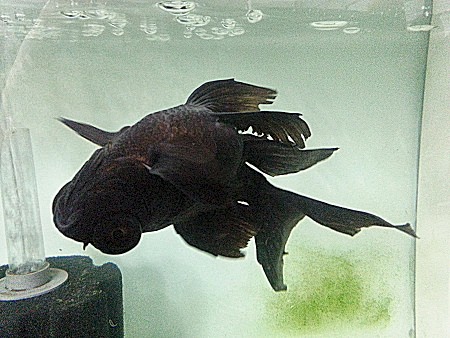| Back to Back Issues Page |
 |
|
The Goldfish Gazette, Issue #088 Buoyancy Issues April 29, 2021 |
Goldfish Care TipsA Free Monthly Resource For Goldfish Enthusiasts In This Issue Buoyancy problems are one of the more common illnesses of fancy varieties, and one of the most difficult to treat. None of us are immune to this if we keep deep bodied varieties. Buoyancy Issues
Black Moor With a Balance ProblemI covered this topic in the #65 issue in May 2019, but it is such a reoccurring theme on Facebook that it deserves another revisit.I also include balance issues under the general term buoyancy issues because balance is controlled by small bones connecting the front air bladder to the inner ear. I currently have a Black Moor that is able to regulate his buoyancy, but has lost his balance. Buoyancy Symptom and CauseIf after feeding dry prepared foods such as flakes or pellets your fish starts having buoyancy issues, usually bouncing like a cork to the surface, it is the food causing it.Confirmation is when the fish returns to normal after a day or two of no feeding. Goldfish are physostomous fish meaning their swim bladders are connected to the gut by a duct called the pneumatic duct. This allows the fish to fill the swim bladders by gulping air or expelling excess gas through the mouth. If the gut is compacted with poor quality food, the fish loses its ability to do this and starts to have buoyancy issues. Compounding the problem is when the food stuck in the gut ferments creating gas in the intestine, which is probably more of a problem than the lack of control. Evidence of this is when bubbles are seen in the faeces. Treatment: Stop feeding until the fish resumes normal buoyancy, then feed only green or live foods for a few days. If you have made a large water change, and suddenly your deep bodied Goldfish loses buoyancy, it may have been caused by a chill. Water temperatures should not be more than 5 degrees Fahrenheit, (2.78oC) colder when changing water or swapping fish between containers otherwise there is a high risk of giving your fish a chill. It’s not such a problem in summer, but it is in the colder months. Treatment: If your water temperature is low, below 65o Fahrenheit (18oC) gradually raise the temperature. Add a little aquarium salt to the water to help boosts the fish’s immune system. If your fish suddenly loses buoyancy and you know it’s not caused by food or a chill, check your nitrate level. Some fish seem susceptible to even low levels of nitrates. Although it was believed Goldfish can take high nitrate levels of up to 300 ppm (parts per million), in a test, my Black Moor started getting buoyancy issues at 80ppm. Nitrates constrict the blood vessels in fish, including those that supply oxygen to the swim bladders. Current thinking is for fancy Goldfish varieties, keep nitrates below 30ppm. Treatment: Change the water and use a water test kit to establish how long it takes for your pond or aquarium nitrates to reach 30ppm. If your fish suddenly loses buoyancy and appears to have lost condition, an internal bacterial attack of the internal organs may have occurred. Treatment: Increase the water temperature into the low 80s Fahrenheit (27oC) and treat with an antibiotic. If your fish starts to gradually lose balance or buoyancy, and you can eliminate all the possible causes above, then suspect genetics, especially if the fish is an older one for example greater than 5 years old. To read more on swim bladder disorders click here…
Comments? Ideas? Feedback? I'd love to hear from you. Just reply to this e-zine and tell me what you think, or what topics you want covered. Next Month's Topic Pond feedingwww.facebook.com/aboutgoldfish |
| Back to Back Issues Page |
